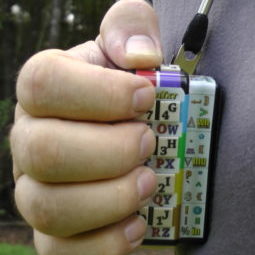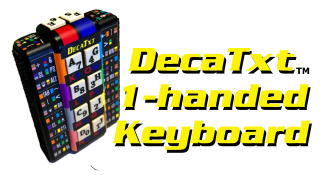How to Operate the DecaTxt Bluetooth Keyboard

DecaTxt keys are pressed simultaneously or in any order, and the keystroke is sent when any key is lifted, with just a few exceptions. The “space”, “Back Space”, “tab” and the four cursor keys will repeat when their key combination is held for a short period of time. Use the DecaTxt Keyboard with either left or right hand. Hold it with the rough surface against your palm just below your fingers and brace the opposite rough surface against your side or leg or desk or bed, anyplace comfortable. Each finger should touch the two keys in the five rows at their position. Alternatively, use both hands if you prefer. The configuration is alphabetic to simplify learning and the label is color coded to help indicate the keys used for each keystroke. Press the button adjacent to the symbol you want plus the key(s) colored like the symbol for that keystroke.
The alphabet uses one finger for the first ten letters (a-j), the next eight letters (k-r) are produced with the right thumb (red) button held and the last eight (s-z) are produced using the left thumb (blue) button held. Press both thumb keys to apply a “shift command” to your next keystroke and easily capitalize letters or provide shifted commands.
Hold both hands out in front of you with your palms down.
Imagine numbering your fingers in this position beginning with the number one (1) on your left pinky finger. This makes your left thumb finger number five (5), your right index finger number seven (7) and your right pinky finger zero. These are the numbers referenced in this document and are printed on the keys of the DecaTxt.

The Alphabet and Numbers – Single Presses and Thumb Shifts
Ask someone to push a button and most often they will extend their right index finger for the task. This is the finger we use to begin the alphabet. By starting on the “7” finger, there are a number of interesting relationships that develop that help make the system easy to learn. The first ten letters are a single tap from each finger.
“a” – right index (7 finger), “b” – right middle (8 finger), “c” – right ring (9 finger), “d” – right pinky (0 finger) “e” – right thumb (6 finger) “f” – left thumb (5 finger), “g” – left index (4 finger), “h” – left middle (3 finger) “i” – left ring (2 finger) & “j” – left pinky (1 finger)
The next eight letters are produced with the right thumb (6 finger) pressed with each of the other keys. The order remains the same starting with the right index (7 finger) but this time skipping the left thumb. So with the 6 finger held, you get “k” by taping the 7 finger, “l” – 8 finger, “m” – 9 finger, “n” – 0 finger, “o” – 4 finger, “p” – 3 finger, “q” – 2 finger & “r” – 1 finger.
The last eight letters are produced the same way but this time with the left thumb (5 finger) included and skipping the right thumb. “s” by tapping the 7 finger, “t” – 8 finger, “u” – 9 finger “v” – 0 finger, “w” – 4 finger, “x” – 3 finger “y” – 2 finger, & “z” – 1 finger.
When both thumbs are pressed, the next character will be shifted, making it simple to create capital letters. If you are using one thumb to make a letter, with it held, simply tap the other thumb before pressing the finger where the letter is located and it will be capitalized. If at any time you discover you have the wrong keys held you can simply add more until 5 keys are pressed and the input will be voided. This helps keep you from having to delete mistakes!
Numbers are provided in this system when Number Lock is turned on (8-0) and they replace the single press alphabet keys a-j using the numbers described above.
The Right Index shift
With the right index (7 finger) held: the 8 finger (t) = tab, 9 finger (c) = comma & 0 finger = apostrophe. The 4 finger = enter, 3 finger (p) = period, the 2 finger (q) = question mark and 1 finger = exclamation point keeping all sentence endings together. Press both thumbs with the (7) right index = space. Both thumbs and the 4 and 7 fingers = ampersand. With both thumbs and the 7 and 8 keys = / forward slash.

The Left Index Shift
With the left index (4 finger) held: the 8 finger (t) = tilde, 9 finger (c) = colon & 0 finger = semi colon. The 3 finger (x) = asterisk, 2 finger (q) = quote(”) and 1 finger = @. Both thumbs with the (4) left index finger = back space. With both thumbs and the 4 and 3 keys = \ back slash. Both thumbs and the 4 and 7 fingers = ampersand.

The Right Middle Shift
For the right middle (8 finger), we take the cue from the letter “L” and use it for the three different locked modes. “L” + “C” to lock capitals (8-9), “L” + “N” to lock numbers (8-0), “L” + “S” + “C” to lock scroll (8-7-9). The “L finger” is also used for the different lines starting with the hyphen on the “h” finger (8-3), underscore is a hyphen plus a “U” (8-3-9), the accent (8-2) and pipe character (8-1). The two thumb keys are used to provide the twelve “F” keys, more on them later.

The Left Middle Shift
For the left middle (3 finger), we take our cue from the letter “p” and use this shift to provide all of the page functions. Page-down with the “p” & “d” fingers (3-0), page-up with the “p” & “u” fingers (3-9). Page End with the right “e” thumb and the left index keys (3-4-6) and Page Home on the left thumb and the left index keys (3-4-5). Pause is the “p” & “z” fingers (3-1) and print screen is the “p” & “s” fingers with the left index (3-4-7). The remaining shifts take their cue from the letter “x” and produce the bent lines such as “less-than” on the “l” finger with the left index (3-4-8), “greater-than” on the “g” finger with the left ring (3-2-4) and the caret on the left ring finger (3-2). (Where you might expect to find a carat!)

The Right Ring Finger
The right ring finger is responsible for c, m, & u (9 finger) so is the shift key for cursor and music use (provided in some applications). It also provides for a few remaining symbols. Hold the right ring finger and get % on the left pinky (9-1) (looks almost like a Z) and # on the right pinky “N” finger (9-0). With the 9 finger and the 0 finger held, the 7 finger becomes music up (9-0-7) and the 8 key becomes music down (9-0-8). Next are the cursor keys, (9-0-6) cursor right, (9-0-5) cursor left, (9-0-4) cursor up and (9-0-3) cursor down. The symbol $ is on the left ring finger (9-0-2) (those carats can be expensive!).

The Left Ring Finger
The left ring (2 finger) is often associated with “marriage” and is thus used for functions that are typically combined together. Pressing the control keystroke before pressing the “c” keystroke is the same as holding control and the “c” key on a traditional keyboard. Using the Left ring with the right ring “C” finger is the “Control” key (2-9), right pinky “D” finger is “Delete” (2-0), and the left pinky is “insert” (2-1) With the left ring and left pinky pressed (2-1), the right thumb “E” finger is “Escape” (2-1-6), the right index “A” finger is the “Alternate” key (2-1-7), the right middle “B” finger is “Break” (2-1-8). The “Windows key” is on the “w” finger (2-1-4), and “Menu” (or Mac key) on the left middle finger (2-1-3) the left thumb “f” is currently reserved to provide additional functions in the future(2-1-5).

The Pinky Shifts
Both right and left pinkies are held for the six various brackets and numeric symbols. “{“ (1-0-2), “[“ (1-0-3), “]” (1-0-4), “}” (1-0-5), “(“ (1-0-8), “)” (1-0-9), the addition symbol, “+” (1-0-7) and the equals symbol, “=“ (1-0-6).

The Function Keys- Right Middle & Right Thumb
With the right middle “8” finger and the right thumb “6” finger held, the left pinky “1” finger is the F1 key (8-6-1), left ring “2” finger for the F2 key (8-6-2), left middle “3” finger for the F3 key (8-6-3), left index “4” finger for the F4 key (8-6-4), the right index “7” finger for the F5 key (8-6-7), and the right ring “9” finger for the F6 key (8-6-9).
The “space” key is typically the most used keystroke so it makes sense to provide this function with a single tap of the left thumb. The right pinky provides a method to swap the position of the “space” key with the “f” key (8-6-0) to assist in making most input a bit more efficient. This however makes the “f” keystroke a three button press (5-6-7). Consider this an advanced user technique.

The Function Keys- Right Middle & Left Thumb
With the right middle “8” finger and the left thumb “5” finger held, the left pinky “1” finger is the F7 key (8-5-1), left ring “2” finger for the F8 key (8-5-2), left middle “3” finger for the F9 key (8-5-3), left index “4” finger for the F10 key (8-5-4), the right index “7” finger for the F11 key (8-5-7), and the right ring “9” finger for the F12 key (8-5-9). The (8-5-0) key is reserved at this time.

These are the standard keys necessary for input but here are some final thoughts to consider. Shifted keystrokes will produce the same symbols as you would normally get from shifted keystrokes on a standard keyboard. For example, if you press and release both thumbs before pressing the “period” keystroke, (5-6, 7-3) you would get the “>” keystroke, a shifted 2 provides an @ symbol. Although this is less efficient, it may help you make keystrokes until you learn the complete system.
We also added vibration feedback to the DecaTxt as an aid to indicate what mode you are in so you can avoid accidentally typing in all caps. Two short blasts for cap lock, one short and one long for number lock. In any mode, one short blast indicates a return to normal mode. It also delivers two long blasts for f-swap and three short blasts when the device pairs successfully. Some devices may break and make connections repeatedly and usually maintaining close proximity prevents excessive vibrations. . If the DecaTxt becomes unresponsive, remove it in your Bluetooth settings, turn Bluetooth off and back on and pair it again. If it doesn’t show up, the battery may be too low and you will need to charge it with a mini USB cable. DecaTxt charges when you see a red glow on the 0 key. The light will go out when it is fully charged in a few hours.
